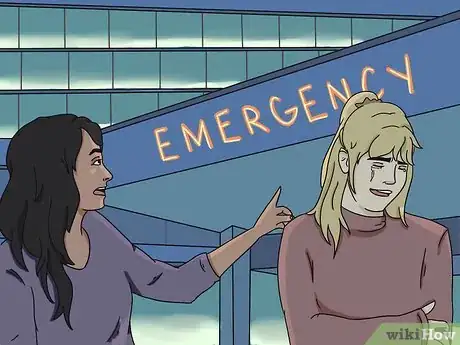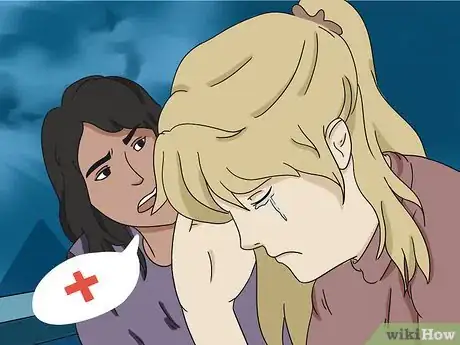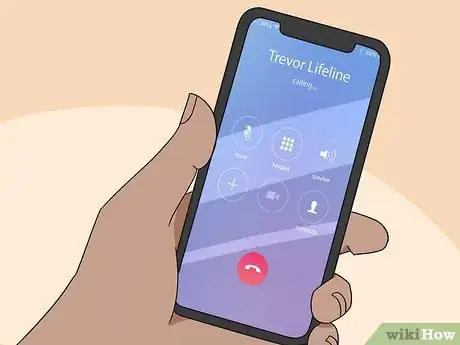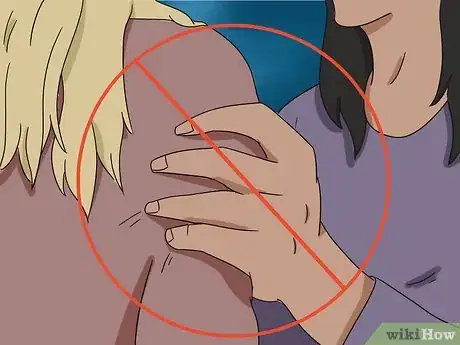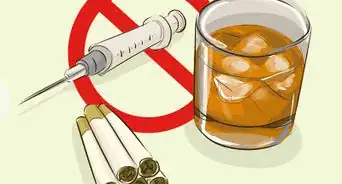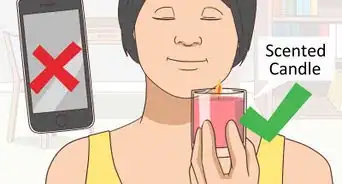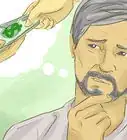This article was co-authored by Asa Don Brown, PhD, DNCCM, FAAETS. Dr. Asa Don Brown is a Clinical Psychologist with over 25 years of experience. He specializes in working with families, children, and couples, treating a variety of psychological disorders, trauma, and abuse. Dr. Brown has specialized in negotiation and profiling. He is also a prolific author having published three books and numerous articles in magazines, journals, and popular publications. Dr. Brown earned a BS in Theology and Religion with a minor in Marketing and an MS in Counseling with a specialization in Marriage and Family from The University of Great Falls. Furthermore, he received a PhD in Psychology with a specialization in Clinical Psychology from Capella University. He is also a candidate for a Masters of Liberal Arts through Harvard University. Dr. Brown is a Fellow of the American Academy of Experts in Traumatic Stress and a Diplomate for the National Center for Crisis Management and continues to serve a number of psychological and scientific boards.
There are 7 references cited in this article, which can be found at the bottom of the page.
This article has been viewed 31,517 times.
If you see someone about to jump off a bridge, you will probably be shocked and scared, which is normal. You might also feel helpless, but there are actually a lot of ways that you may be able to help. The best thing to do is call or text emergency services and the Suicide and Crisis Lifeline at 988. Then, start talking to the person so that they know they’re not alone. Listen if they want to talk to you. This can be a really stressful situation, so make sure to take care of yourself after it's over.
Steps
Calling for Help
-
1Call emergency services to alert the authorities. You’re likely not an expert in helping people in crisis, so make sure to call the people who are. Use your cell phone to call for help. Tell them that you are with someone who looks like they are going to jump off a bridge and provide your location. If you have any other information, tell the dispatcher that. [1]
- For example, if the person seems to be intoxicated or on drugs, you should tell the dispatcher your suspicions. You should also let them know if the person appears to have a weapon.
- If you don’t have your phone on you, ask someone nearby to make the call for you.
-
2Phone or text the Suicide and Crisis Lifeline to get support. This hotline is a great resource for people contemplating suicide. Dial 988 and tell the person trained to help what is going on. Ask the person about to jump if they are willing to talk on the phone. If they are, let them use your phone. [2]
- Stay on the line even if the person ready to jump doesn’t want to talk on the phone. The people at the lifeline can offer you support and help you figure out how to best help the person in distress.
- The people at the Trevor Project can also provide support and resources for you. This is a really emotional situation for you, too.
Advertisement -
3Ask if you can take them to the emergency room. Medical professionals can help calm the person through physical treatment or psychiatric care. Offer to give the person a ride to the nearest hospital if you feel comfortable. If you are at all concerned for your own safety, do not make this offer.[3]
- If they don’t want to go, don’t try to force them.
-
4Offer to call a loved one or a doctor. You don’t have to handle this situation all alone. After you’ve called the authorities, you can try to get others to help, too. Ask the person if there is a friend or family member they want you to call. You can also ask if they have a therapist or medical professional that they want to talk to.[4]
- If you know the person, you might suggest a loved one that you could call. Don’t try to force the issue if they don’t agree.
-
5Reach out to the Trevor Lifeline for the LGBTQ community. If the person has mentioned that they are LGBTQ, call the hotline that specializes in helping this community. In the US, dial 1-866-488-7386 and tell the person who answers what is going on. Ask the person in distress if they want to speak to a counselor and offer them your phone if they say yes. [5]
Talking Calmly to the Person
-
1Stay near the person so they are not alone. If you see someone standing on a ledge or who has climbed the railing of a bridge, do not just walk away. It’s okay to feel scared and nervous but stay near the person so that you can try to help. If you try to approach and they ask you to step back, you should respect that. [6]
- Feeling completely alone might cause someone to be suicidal. By staying near them, you are giving a visible sign that someone sees them and cares.
-
2Talk to them in a compassionate, understanding way. A police officer has dealt who has dealt with this many times suggests that a kind tone and words can really help here. Keep your voice calm and try to strike up a conversation. You can let them know that they are not alone and that you want to help them. Look them in the eye and say that you don't want them to jump. Whatever you choose to say, be genuine and kind. [7]
- You could say, “I’m here and I’m going to stay here. You are not alone.”
- Say, "Your life matters." This simple statement is often the most powerful.
- Show that you empathize by saying, “I understand why you're so upset. ”
-
3Listen to anything they have to say. If the person responds to you, make it clear that you are willing to listen. You can do this verbally by saying, “I’m listening. I’m here for you.” You can also use non-verbal cues such as making eye contact or nodding at what they say.[8]
- Don’t interrupt or otherwise discourage them from talking.
- Allow them to freely express their feelings of desperation, frustration, and personal challenges. Don’t judge or question what they are upset about.
-
4Offer words of hope. It might be really difficult to stay positive in this scary situation but try to give the person something good to focus on. If you know the person, you can tailor this to what they’re going through. Even if you don’t know the person, you can still find a way to encourage them. [9]
- If they have told you something specific, you could say, “Maybe there is a way for you to feel closer to your family.” If you have no information, you can still say, “There are a lot of people out there who can help you.”
-
5Take the person seriously. Standing on a bridge getting ready to jump is a serious cry for help. Do not try to make light of this by acting like the person doesn’t really mean it. Avoid saying things like, “I know you’re don’t mean this” or “You don’t really want to do this.” Instead, treat the situation like the serious matter that it is. [10]
-
6Do not argue or make promises. You could make the situation worse if you react negatively to the person about to jump. Even if you think they are wrong for being on the bridge, or you disagree with something they say, don’t try to argue with them. That could just cause further distress. Also, take care not to promise that things will change or that you can help them fix everything. You’ll likely be very stressed in this situation, but it’s important not to make promises you can’t keep. [11]
- Don’t say something like, “I doubt it’s true that you’re going to get fired. You’re probably overreacting.” You don’t want to invalidate their feelings.
- While you probably want to help in any way you can, avoid saying things like, “I’ll make sure that we can track down your mom so that you can mend your relationship.” You likely can’t ensure that outcome.
Taking Helpful Physical Action
-
1Make eye contact and smile. Try following this advice from a police officer who has encountered many people in this situation. If you're crossing a bridge and you see someone acting anxious, give them a friendly wave and a smile. Many times, a friendly face might be just what someone on a bridge needs. [12]
- Pacing back and forth or talking to themselves could be a sign that someone is in distress. Also notice whether they have put down their personal items, like a briefcase or backpack. If they're leaving their stuff behind, they might be thinking about jumping.
-
2Approach a potential jumper casually. Don't run at someone and get into their physical space. Instead, walk at a normal pace towards the potential jumper. You don't have to ask them directly if they are going to jump. Just strike up a conversation. [13]
- You can say, "How are you today?" You could also make a simple comment about the weather. The point is to engage them and let them know you are there.
-
3Use open body language to show that you care. When you start talking to the person, make sure to make eye contact to show that you are listening. You should also look approachable, so don't stand with your arms crossed. That can make you seem defensive or even judgemental.[14]
- Nodding your head can also indicate that you are listening and reacting empathetically to what the person says.
-
4Don't try to physically stop the person from jumping. Even though you might instinctively reach out and grab them, don't do it. When you make a grab for someone, their natural instinct might be to scoot away from you, which could cause them to slip and fall.[15]
- Grappling with the person can also put you in harm's way. To say safe, avoid any physical contact.
Dealing With the Aftermath of the Situation
-
1Talk to friends and family about your feelings. After you are away from this stressful situation, it's normal to be really emotional. You might feel angry, scared, helpless, sad, or a combination of all of these emotions. Reach out to people you trust and ask them to support you. Talk to them about how you feel so that you can process your emotions.
- You could say to your sister, "I'm really shaken up by what I dealt with yesterday. Could you come over to hang out and talk with me?"
-
2Take care of your body and do relaxing activities to ease stress. You might feel out of sorts for a while. As you heal, make it a point to eat healthy foods like whole grains, veggies, and fruits. Try to get 7-9 hours of sleep each night so that you feel well-rested. It's also a good idea to try to exercise daily, which can relieve stress.You can also ease stress by:[16]
- Getting out into nature
- Trying yoga and meditation
- Reading a good book
- Spending time with friends
-
3Make an appointment with a counselor if you need to. Sometimes professional treatment is necessary after a traumatic situation. If you don't feel like you're getting back to yourself after a week or so, try talking to a mental health care professional. You can ask your doctor for a referral, or ask friends and family if they can recommend a good counselor.[17]
- Look for a counselor who has experience in helping people process very stressful situations.
Community Q&A
-
QuestionWhat do I do if someone has overdosed on paracetamol?
 NicoTop AnswererOverdose caused by paracetamol is the most common form of overdose and can result in liver failure. Call the authorities right away or take the person affected to a hospital/emergency room.
NicoTop AnswererOverdose caused by paracetamol is the most common form of overdose and can result in liver failure. Call the authorities right away or take the person affected to a hospital/emergency room.
Warnings
- If the person is violent, do not approach them. Call emergency services.⧼thumbs_response⧽
- Do not blame yourself if someone commits suicide. It is not your fault.⧼thumbs_response⧽
References
- ↑ https://www.psychologytoday.com/us/blog/compassion-matters/201309/how-can-you-stop-suicide
- ↑ https://suicidepreventionlifeline.org/how-we-can-all-prevent-suicide/
- ↑ https://www.psychologytoday.com/us/blog/compassion-matters/201309/how-can-you-stop-suicide
- ↑ https://www.mayoclinic.org/diseases-conditions/suicide/in-depth/suicide/art-20044707
- ↑ https://www.thetrevorproject.org/resources/guide/preventing-suicide/
- ↑ https://www.mayoclinic.org/diseases-conditions/suicide/in-depth/suicide/art-20044707
- ↑ https://www.vice.com/en_us/article/mvk3jp/i-talked-hundreds-of-people-out-of-jumping-off-the-golden-gate-bridge
- ↑ https://www.helpguide.org/articles/suicide-prevention/suicide-prevention.htm
- ↑ https://www.helpguide.org/articles/suicide-prevention/suicide-prevention.htm
- ↑ https://www.helpguide.org/articles/suicide-prevention/suicide-prevention.htm
- ↑ https://www.helpguide.org/articles/suicide-prevention/suicide-prevention.htm
- ↑ https://www.vice.com/en_us/article/mvk3jp/i-talked-hundreds-of-people-out-of-jumping-off-the-golden-gate-bridge
- ↑ https://www.vice.com/en_us/article/mvk3jp/i-talked-hundreds-of-people-out-of-jumping-off-the-golden-gate-bridge
- ↑ https://www.vice.com/en_us/article/mvk3jp/i-talked-hundreds-of-people-out-of-jumping-off-the-golden-gate-bridge
- ↑ https://www.helpguide.org/articles/suicide-prevention/suicide-prevention.htm
- ↑ https://www.suicidecallbackservice.org.au/resource/looking-after-yourself/
- ↑ https://www.suicidecallbackservice.org.au/resource/looking-after-yourself/


